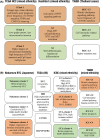Molecular genomic landscapes of hepatobiliary cancer
- PMID: 29573058
- PMCID: PMC5980207
- DOI: 10.1111/cas.13582
Molecular genomic landscapes of hepatobiliary cancer
Abstract
Hepatocellular carcinoma (HCC) and biliary tract cancer are more frequent in East Asia including Japan than in Europe or North America. A compilation of 1340 multi-ethnic HCC genomes, the largest cohort ever reported, identified a comprehensive landscape of HCC driver genes, comprised of three core drivers (TP53, TERT, and WNT signaling) and combinations of infrequent alterations in various cancer pathways. In contrast, five core driver genes (TP53, ARID1A, KRAS, SMAD4, and BAP1) with characteristic molecular alterations including fusion transcripts involving fibroblast growth factor receptor 2 and the protein kinase A pathway, and IDH1/2 mutation constituted the biliary tract cancer genomes. Consistent with their heterogeneous epidemiological backgrounds, mutational signatures and combinations of non-core driver genes within these cancer genomes were found to be complex. Integrative analyses of multi-omics data identified molecular classifications of these tumors that are associated with clinical outcome and enrichments of potential therapeutic targets, including immune checkpoint molecules. Translating comprehensive molecular-genomic analysis together with further basic research and international collaborations are highly anticipated for developing precise and better treatments, diagnosis, and prevention of these tumor types.
Keywords: biliary tract cancer; driver gene; hepatocellular carcinoma; molecular classification; mutational signature.
© 2018 The Authors. Cancer Science published by John Wiley & Sons Australia, Ltd on behalf of Japanese Cancer Association.
Figures






References
-
- Shibata T, Aburatani H. Exploration of liver cancer genomes. Nat Rev Gastroenterol Hepatol. 2014;11:340‐349. - PubMed
-
- Zheng S, Zhu Y, Zhao Z, Wu Z, Okanurak K, Lv Z. Liver fluke infection and cholangiocarcinoma: a review. Parasitol Res. 2017;116:11‐19. - PubMed
-
- Totoki Y, Tatsuno K, Covington KR, et al. Trans‐ancestry mutational landscape of hepatocellular carcinoma genomes. Nat Genet. 2014;46:1267‐1273. - PubMed
Publication types
MeSH terms
LinkOut - more resources
Full Text Sources
Other Literature Sources
Medical
Research Materials
Miscellaneous

